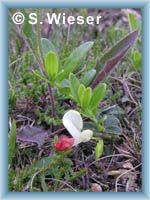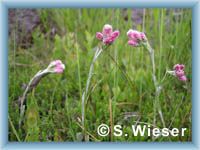Plants of Slavkov Forest
An uninterrupted canopy of trees gives way to carpets of peat moss,below wastelands of twisted pine relicts. It is pushed apart by the Teplá River canyon, where the towns of Horní Slavkov and Beeov will one day stand. The gloom of the beech groves alternates with illuminated oak woods. This would have been what the first medieval settlers saw, had they beheld todays Slavkov reserve from above. Present-day visitors' view would probably be confined to the broad forest complex near Kladská and the landscape quilt of the Teplá area. Let's start our tour of the reserve right at its heart the Kladská peat bogs. The upland moors developed through the collision of fertile foothills after the glaciers receded, about 10000 years ago. It's no wonder the bogs depth can be measured in meters (8m at the former Krásno bog). The bog's life begins and ends with uncompleted peat moss growth - while the upper part grows constantly, the lower part gradually dies out. Different mosses grow in the water-submerged areas between the tufts, and still others on the tufts themselves. The surface of the bog gradually becomes wooded, first with mountain pine, then with Norway spruce. Today the Kladská bog is in this end phase. Only a few plants have succeeded in adapting to bog life: the round-leaved sundew, bog rosemary, European cranberries, crowberries and cottongrass.Not only the peat bog, with its specific local conditions, creates a unique biotope. The crest extending northeast from Mariánské Lázni is an inimitable environment hosting highly unusual flora, thanks to the chemical-physical qualities of the serpentine rock that makes it up (high in magnesium, low in calcium). The specific soil chemistry and the island-like serpentine outcrops, both here and worldwide, induce certain species to specialize in serpentine substrates. On the socalled Mnichov serpe ntines grow spleenwort (asplenium adulterinum and cuneifolium), and endemic to the area, mouse-eared chickweed and huperzia selago. Species like eyebright, common to other areas, form dwarf varieties on serpentine. Besides rock vegetation, shrubs are present: winter heath, creeping evergreen, bilberry, bog bilberry, cowberry and scots pine.Finally, to show the diversity of the serpentine biotope, we should not leave out carnations, catchfly, arnica montana (the centerpiece of the reserve's emblem), bedstraw (galium sudeticum ), moonwort and others.The reserve has not only serpentine, but outcrops of granite (e.g. the Svatos Rocks) and amphibolite. The rare fragrant woodsia grows on amphibolite rocks in the Teplá River canyon.So far we've concentrated on the reserves unique biotopes, but for a complete tour we should now focus on vegetation common to the whole territory (if only in the past). Forests: Original forest growth is rare today. One finds remnants of water-logged spruce woods, as well as florid beech woods (e.g., the Holina reserve near Lázne Kynzvart) with bittercress, Solomons seal, sweet woodruff, rattleSnake root, veronica montana and wild rye.
The area of Slavkov Forest includes 26 small - national natural reserves (NNR), national natural monuments (NNM), natural reserves (NR) and natural monuments (NM).
You can visit some of these places on tourist ways:
· NNR peat-bogs Kladské rašeliny (5 lokalies, Tajga is accessible on nature trail)
· NR Smraďoch – nature trail
· NR Vlček – access on blue tourist way from Prameny
· NNM Křížky – informative tables
· NNM rocks Svatošské skály – nature trail, access on blue tourist way Carlsbad – Loket
· NM rock Šemnická skála – access on yellow tourist way from Andělská Hora
· NNM meadow Upolínová louka – sight only from road near Prameny
· NR Holina – access on green tourist way from Lázně Kynžvart
· NR valley of river Teplá – road or railway through valley
· NM rock Dominova skalka – access on green tourist way from Bečov nad Teplou
· NM rock Kynžvartský kámen – access on yellow tourist way from Lázně Kynžvart
· NM rock formation Čedičové varhany u Hlinek – access from road Hlinky – Přílezy
· NM spring Koňský pramen – access on red tourist way from Chotěnov
· NM Čiperka – access on green tourist way from Michalovy Hory
· NR hill Podhorní vrch – access on red tourist way Mariánské Lázně, Ovesné, Kladruby
· NM Moučné pytle – access on green tourist way from Carlsbad to Horní Slavkov
Deforested territory: Because the reserve is a spring region, we most often encounter wetland vegetation, which includes the areas most diverse and threatened varieties. One finds the broad-leaved marsh orchid, the spotted orchid and corallorhiza trifida. Other wetland types include the swamp willow,lousewort, wood betony, butterwort, yellow expanses of globeflower, Siberian iris, miners lettuce, marsh trefoil, sedge (carex puIicaris), and vignea davalliana and these are just the officially protected varieties. Wetlands often give way to once unfertilized, mown, florid meadows with green-winged orchids, the lesser butterfly orchid, buttercups, the spiked rampion, bellflower (campanula sp.), plume thistle bird's eye, star thistle, fescue, broad -leaved meadowgrass, trisetum flavescens, cat tails, meadow foxtail, bumet bloodwort, snakeweed and others.Ponds and their surrounding plants have been part of any civilized Central European landscape since medieval times. Water vegetation includes milfoils which catch tiny water organisms in their follicles - the reserve has two types, utr-icularia australis and the rarer utricularria minor (lesser bladderwort). Among knotweeds we should mention at least the protected Alpine pondweed, batrachium aquatile, and Canadian waterweed introduced from North America, water starwort and duckweed which floats on the surface. Bank vegetation: the rare sparganium minimum, creeping spike rush, and sedge. To focus on unique vegetation,however, would be closing our eyes to the ruderal plant groups inseparable from any landscape affected by people - dumps where goosefoot and stringing grow, highway ditches with French rye and parsnip chervil, for example. Unfortunately, these ruderal types, through their competitive strength and ecological adaptability, threaten many more naturally occurring flora. Notorious for this in the reserve is the cartwheel flower. As we see, todays landscape greatly varies from the virgin expanses of the Middle Ages. Many plant communities have changed or disappeared (forests, wetlands), others have been replaced (ponds, pastures and florid meadows).
The area of Slavkov Forest includes 26 small - national natural reserves (NNR), national natural monuments (NNM), natural reserves (NR) and natural monuments (NM).
You can visit some of these places on tourist ways:
· NNR peat-bogs Kladské rašeliny (5 lokalies, Tajga is accessible on nature trail)
· NR Smraďoch – nature trail
· NR Vlček – access on blue tourist way from Prameny
· NNM Křížky – informative tables
· NNM rocks Svatošské skály – nature trail, access on blue tourist way Carlsbad – Loket
· NM rock Šemnická skála – access on yellow tourist way from Andělská Hora
· NNM meadow Upolínová louka – sight only from road near Prameny
· NR Holina – access on green tourist way from Lázně Kynžvart
· NR valley of river Teplá – road or railway through valley
· NM rock Dominova skalka – access on green tourist way from Bečov nad Teplou
· NM rock Kynžvartský kámen – access on yellow tourist way from Lázně Kynžvart
· NM rock formation Čedičové varhany u Hlinek – access from road Hlinky – Přílezy
· NM spring Koňský pramen – access on red tourist way from Chotěnov
· NM Čiperka – access on green tourist way from Michalovy Hory
· NR hill Podhorní vrch – access on red tourist way Mariánské Lázně, Ovesné, Kladruby
· NM Moučné pytle – access on green tourist way from Carlsbad to Horní Slavkov
Deforested territory: Because the reserve is a spring region, we most often encounter wetland vegetation, which includes the areas most diverse and threatened varieties. One finds the broad-leaved marsh orchid, the spotted orchid and corallorhiza trifida. Other wetland types include the swamp willow,lousewort, wood betony, butterwort, yellow expanses of globeflower, Siberian iris, miners lettuce, marsh trefoil, sedge (carex puIicaris), and vignea davalliana and these are just the officially protected varieties. Wetlands often give way to once unfertilized, mown, florid meadows with green-winged orchids, the lesser butterfly orchid, buttercups, the spiked rampion, bellflower (campanula sp.), plume thistle bird's eye, star thistle, fescue, broad -leaved meadowgrass, trisetum flavescens, cat tails, meadow foxtail, bumet bloodwort, snakeweed and others.Ponds and their surrounding plants have been part of any civilized Central European landscape since medieval times. Water vegetation includes milfoils which catch tiny water organisms in their follicles - the reserve has two types, utr-icularia australis and the rarer utricularria minor (lesser bladderwort). Among knotweeds we should mention at least the protected Alpine pondweed, batrachium aquatile, and Canadian waterweed introduced from North America, water starwort and duckweed which floats on the surface. Bank vegetation: the rare sparganium minimum, creeping spike rush, and sedge. To focus on unique vegetation,however, would be closing our eyes to the ruderal plant groups inseparable from any landscape affected by people - dumps where goosefoot and stringing grow, highway ditches with French rye and parsnip chervil, for example. Unfortunately, these ruderal types, through their competitive strength and ecological adaptability, threaten many more naturally occurring flora. Notorious for this in the reserve is the cartwheel flower. As we see, todays landscape greatly varies from the virgin expanses of the Middle Ages. Many plant communities have changed or disappeared (forests, wetlands), others have been replaced (ponds, pastures and florid meadows).
Back Home Slavkov Forest
Czech mountains - Catalogues of accommodation:



